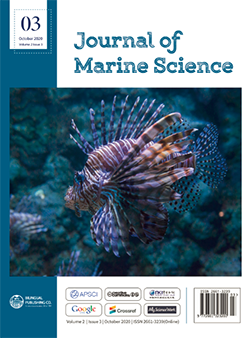Diversity and Abundance of Copepods in Taninthayi Coastal Waters, Myanmar
DOI:
https://doi.org/10.30564/jms.v2i3.2437Abstract
Diversity and abundance of copepods occurring in Taninthayi coastal waters were studied and analyzed from the samples collected by R/V DR. FRIDTJOF NANSEN during the Myanmar ecosystem survey 2018. Seventy-nine copepods species belonging to calanoids (51 species), cyclopoids (21 species), and harpacticoids (7 species) were identified in the copepods community of Taninthayi coastal waters. Copepods species number and density were high at the nearshore stations (Sts 799, 842, 788) and low at the offshore stations (Sts 846, 802, 823). The resulted diversity index values of copepods were varied from 2.61 to 3.78 in species diversity index (H'), from 0.89 to 0.97 in the evenness index (E'), and from 2.51 to 7.50 in species richness index (D'). According to the correlation matrix, the abundance of copepods was positively correlated with temperature, chlorophyll a and fluorescence, and negatively correlated with salinity and oxygen.
Keywords:
Abundance; Copepods; Calanoids; Cyclopoids; HarpacticoidsReferences
[1] Han Shein. Study on some marine plankton copepod of Myanmar Waters. Unpublished M.Sc. Thesis, Department of Marine Biology, Art and Science Yangoon Universtiy, Yangoon, Myanmar, 1975.
[2] Aung Kyi, U. Sudy of the morphology and abundancy of copepods from the mouth of the Salween River estuary. Unpublished M. Sc. Thesis. Department of Zoology, Art and Science University, Ragoon, Myanmar, 1976.
[3] Gayder Kittim Ku, U. The systematic of some planktonic copepod and their distribution during the pre and post monsoon in the Gulf of Martaban. Unpublished M. Sc. Thesis. Department of Zoology, Art and Science University, Ragoon, Myanmar, 1979.
[4] Zin Lin Khine. Zooplankton Species Composition and Distribution of Southern Myanmar Waters. Myeik University Research Journal, 2014, 5(1): 101-122.
[5] Kasturirangan, L.R. A key for the identification of the more common planktonic copepod of Indian coastal waters. Council of scientific and industrial research, New Delhi, 1963: 91.
[6] Newell, G.E, Newell, R.C. Marine plankton; a practical guide. University of London Press, London, 1973: 225.
[7] Ludwig, J.A., Renylods, J. F. Statistical ecology a primer on methods and computing. Wiley international Press, America, 1988: 202.
[8] Jeffrey, S.W., Humphrey, G.F. New spectrophotometric equations for determining chlorophyll a, b, cl and c2 in higher plants, algae and natural phytoplankton. Biochemie und Physiologie der Pflanzen, 1975, 167: 191-194.
[9] Zin Lin Khine. Plankton Diversity in the waters off Ayeyarwaddy and Taninthayi Coasts. Unpublished M. Res Thesis. Department of Marine Science, Myeik University, Myeik, Myanmar, 2008.
[10] Kavitha, M., Padmavathy, P., Srinivasan, A., Jawahar, P., Ranjith, L., Prabu, D. L. Copepod abundance and Diversity from offshore region of Tuticorin, south east coast of India. International Journal of current Microbiology and Applied Science, 2018, 7(4): 2767-2792.
[11] Shanthi, M., Ramanibai, R.. Studies on copepods from Chennai coast (Cooum and Adyar), Bay of Bengal- during the Cruise. Current Research Journal of Biological Sciences, 2011, 3(1): 132-136.
[12] Shah, J. A., Pandit, A. K., Shah, G. M. Distribution, diversity and abundance of copepod zooplankton of Wular Lake, Kashmir Himalaya. Journal of Ecology and the Natural Environment, 2013, 5(2): 24-29.
[13] Nassar, M, Z. A., Gharib, S. M. Spatial and temporal patterns of phytoplankton composition in Burullus lagoon, Southern Mediterranean Coast, Egypt. Egyptian Journal of Aquatic Research, 2014, 40: 133-142.
[14] Abdel-Aziz, N. e., Ghobashi, A. e., Dorgham, M. M., El-Tohami, W. S. Qualitative and quantitative study of copepods in Damietta harbor, Egypt. Egyptian Journal of Aquatic Research, 2017, 33(1): 144-162.
[15] Fazeli, N., Marnani, H. R., Sanjani, S., Zare, R., Dehghan, S., Jahani, N. Seasonal variation of copepoda in Chabahar Bay Gulf of Oman. Jordan Journal of Biological Sciences, 2010, 3(4): 153-164.
Downloads
Issue
Article Type
License
Copyright and Licensing
The authors shall retain the copyright of their work but allow the Publisher to publish, copy, distribute, and convey the work.
Journal of Marine Science publishes accepted manuscripts under Creative Commons Attribution-NonCommercial 4.0 International License (CC BY-NC 4.0). Authors who submit their papers for publication by Journal of Marine Science agree to have the CC BY-NC 4.0 license applied to their work, and that anyone is allowed to reuse the article or part of it free of charge for non-commercial use. As long as you follow the license terms and original source is properly cited, anyone may copy, redistribute the material in any medium or format, remix, transform, and build upon the material.
License Policy for Reuse of Third-Party Materials
If a manuscript submitted to the journal contains the materials which are held in copyright by a third-party, authors are responsible for obtaining permissions from the copyright holder to reuse or republish any previously published figures, illustrations, charts, tables, photographs, and text excerpts, etc. When submitting a manuscript, official written proof of permission must be provided and clearly stated in the cover letter.
The editorial office of the journal has the right to reject/retract articles that reuse third-party materials without permission.
Journal Policies on Data Sharing
We encourage authors to share articles published in our journal to other data platforms, but only if it is noted that it has been published in this journal.




 Khin May Chit Maung
Khin May Chit Maung

